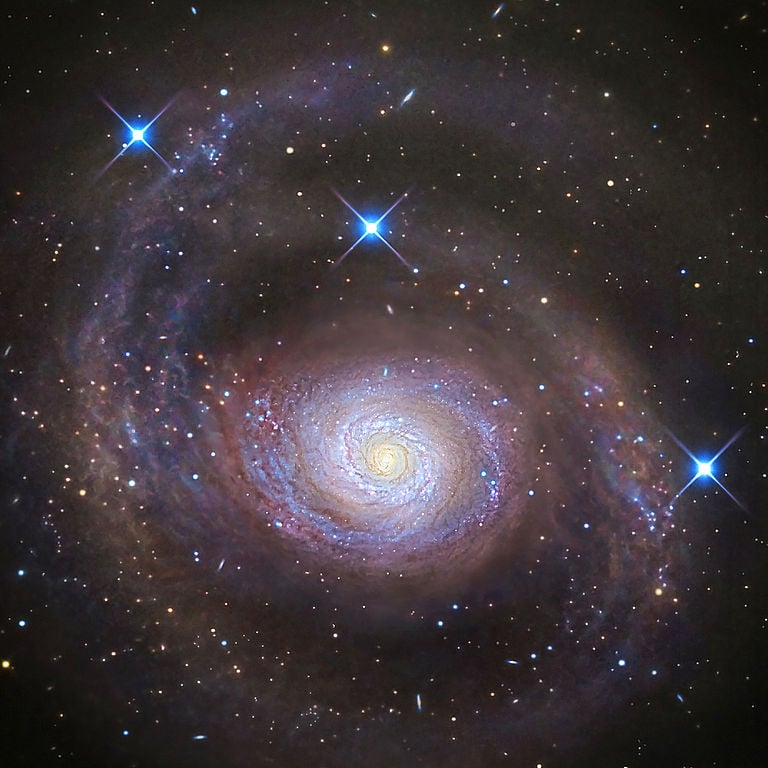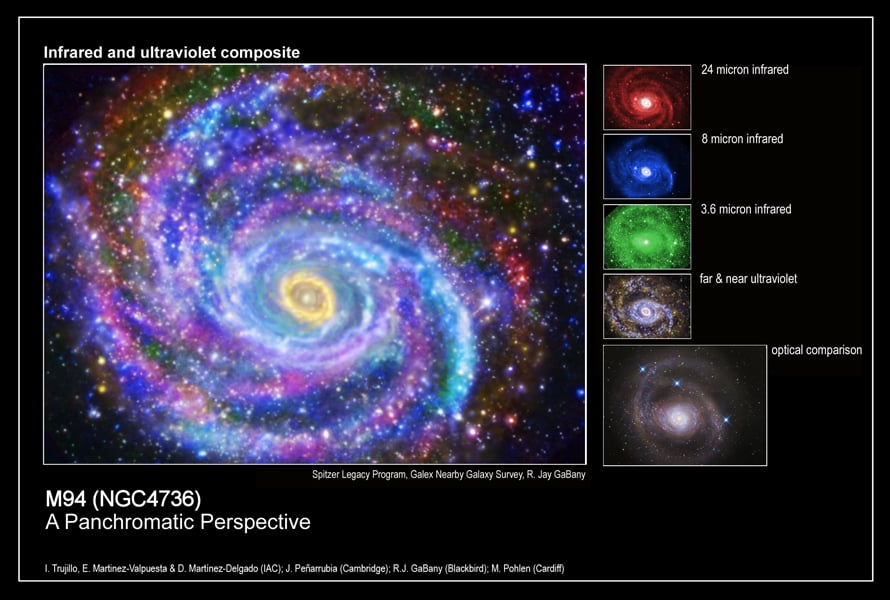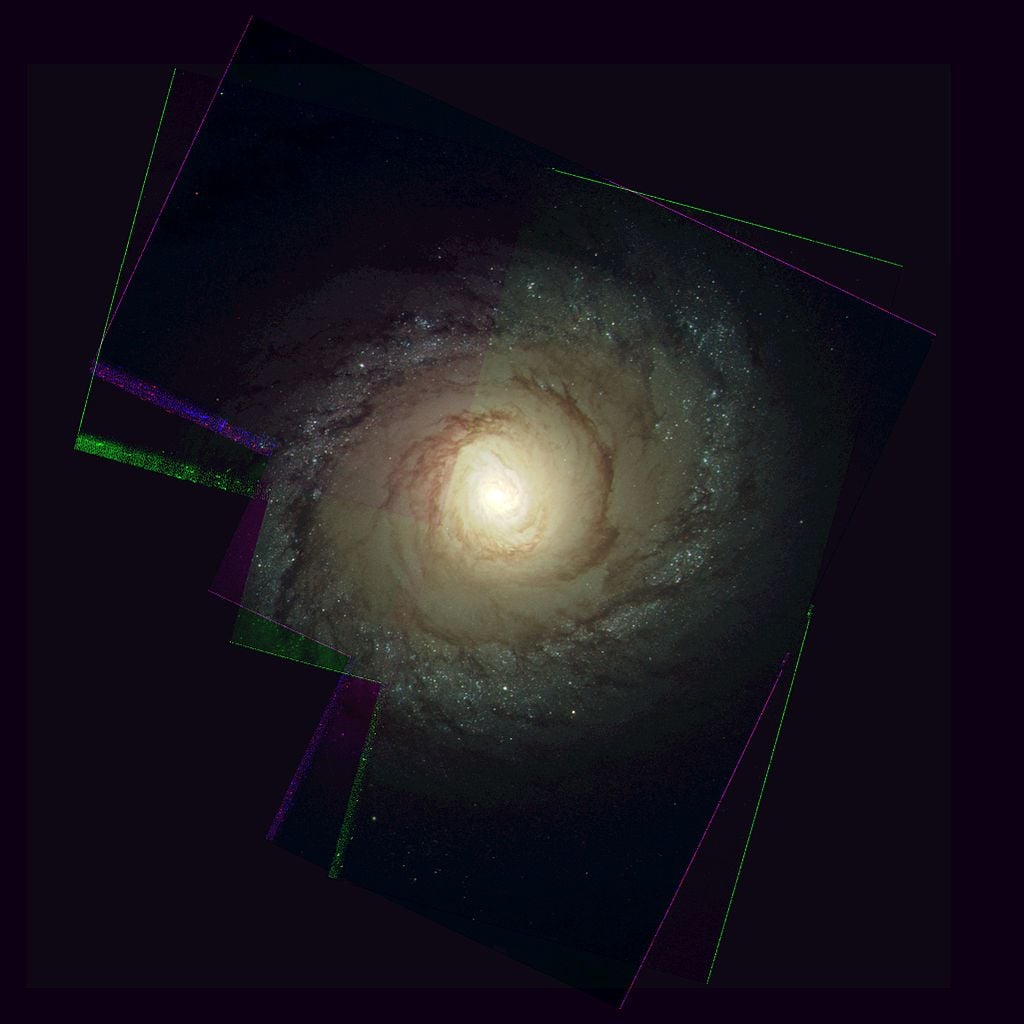Welcome back to Messier Monday! Today, we continue in our tribute to our dear friend, Tammy Plotner, by looking at the "Cat's Eye" spiral galaxy known as Messier 94!
During the 18th century, famed French astronomer Charles Messier noticed the presence of several "nebulous objects" while surveying the night sky. Originally mistaking these objects for comets, he began to catalog them so that others would not make the same mistake. Today, the resulting list (known as the Messier Catalog) includes over 100 objects and is one of the most influential catalogs of Deep Space Objects.
One of these objects is the Cat's Eye Galaxy (aka. the Croc's Eye Galaxy and Messier 94), a spiral galaxy located about 15 million light-years from Earth in close proximity to the Canes Venatici constellation (and just north-east of Ursa Major). Measuring 50,000 light-years in diameter, this galaxy can be spotted with binoculars on a clear night - but only as a small patch of light. However, even with small telescopes, this object is discernible as a galaxy.
What You Are Looking At:
While you might not see barred structure in your observations, Messier 94 was classified Sab because of its extremely bright nucleus. Around the brilliant circular disk is a ring of active star-forming regions, revealed in astrophotography as blue young star clusters. This artifact delineates it from the faded outer ring of an older yellowish stellar population.
However, on the frontier, there is another stellar producing ring! This makes M94 a rare galaxy indeed... one in which we can witness "waves" of new stars coming into creation. Said Ignacio Trujillo (et al) in a 2009 study:
"We have conducted a deep multiwavelength analysis (0.15-160 ?m) to study the outer region of the nearby galaxy M94. We show that the non-optical data support the idea that the outskirts of this galaxy are not formed by a closed stellar ring (as traditionally claimed in the literature) but by a spiral arm structure. In this sense, M94 is a good example of a Type III (anti-truncated) disk galaxy having a very bright outer disk. The outer disk of this galaxy contains ~23% of the total stellar mass budget of the galaxy and contributes ~10% of the new stars created showing that this region of the galaxy is active. In fact, the specific star formation rate (SFR) of the outer disk (~0.012 Gyr–1) is a factor of ~2 larger (i.e., the star formation is more efficient per unit stellar mass) than in the inner disk. We have explored different scenarios to explain the enhanced star formation in the outer disk. We find that the inner disk (if considered as an oval distortion) can dynamically create a spiral arm structure in the outer disk which triggers the observed relatively high SFR as well as an inner ring similar to what is found in this galaxy."
But there is a whole lot there to look at in various forms of the electromagnetic spectrum. Let's take a deeper look into the central core - the nucleus. As C.Moellenhoff (et al) said in their 1995 study:
"Visual, NIR, and H_alpha surface photometry of the oval disk galaxy M94 (NGC 4736) was performed to study the distribution of mass in old stars and the distribution of the warm emission line gas. The radial profile of the inner stellar disk is steeper than exponential and displays twisted and deformed isophotes. Dust is not responsible for these deviations. The investigation of a number of morphological models showed that M94 has a weak central stellar bar of 0.7 kpc major axis length which comprises about 14 per cent of the total light within 20 arcsec." "By means of longslit spectroscopy the kinematics of gas and stars in this region were investigated. The stellar kinematics reveal the existence of a small spheroidal bulge with v/sigma of about 0.8. The stellar velocity field in this region is approximately axisymmetric, showing that the effects of the bar on the kinematics of the hot component are relatively small. The warm gas in the bar region shows global and local deviations from the stellar kinematics, but outside the central bar fits into the general HI velocity field. Model calculations of closed orbits for gas in the potential of the bar perturbation and axisymmetric disk and bulge predict large non-circular motions for cold gas in equilibrium flow. These do not fit the central H_alpha kinematics; rather it appears that the H_alpha gas must have large random motions and is not in a steady state, and that hydrodynamical effects due to a recent starburst play a role in the central region."
Shall we visit the local bar before we leave the neighborhood? William H. Waller (et al) had this to say about it in a 2000 study:
"The HST Faint Object Camera image resolves the NUV emission from the nuclear region into a bright core and a faint 20'' long "minibar" at a position angle of 30°. Optical and IUE spectroscopy of the nucleus and diffuse inner disk indicates a ~107–108 yr old stellar population from low-level star-birth activity blended with some LINER activity. Analysis of the H?-, FUV-, NUV-, B-, R-, and I-band emissions, along with other observed tracers of stars and gas in M94, indicates that most of the star formation is being orchestrated via ring-bar dynamics, involving the nuclear minibar, inner ring, oval disk, and outer ring. The inner starburst ring and bisymmetric knots at intermediate radius, in particular, argue for bar-mediated resonances as the primary drivers of evolution in M94 at the present epoch. Similar processes may be governing the evolution of the "core-dominated" galaxies that have been observed at high redshift."
History of Observation:
M94 was discovered by Pierre Méchain on March 22nd, 1781. Getting the report of his friend, Charles Messier observed it, determined its position and cataloged it on March 24, 1781. In his notes he stated:
"Nebula without star, above the Heart of Charles [Alpha Canum Venaticorum], on the parallel of the star no. 8, of sixth magnitude of the Hunting Dogs [Canes Venatici], according to Flamsteed: In the center it is brilliant and the nebulosity [is] a bit diffuse. It resembles the nebula which is below Lepus, No. 79; but this on is more beautiful and brighter: M. Méchain has discovered this one on March 22, 1781."
On March 18th, 1787, Sir William Herschel got a much better look with his larger telescope... Enough of a look to see structure. In his unpublished notes he writes: "Very brilliant, a large, luminous nucleus of more than 20" diameter with faint chevalure and branches extending 6 or 8'." M94 would be later observed by Herschel son John many times, where he once described it as:
"Not resolved but resolvable. (A very interesting object, being a neb v s m b M on a great scale.) Very bright; very suddenly much brighter toward the middle; 4' diameter. Not resolved but resolvable [mottled]. (A very interesting object, being a nebula very suddenly much brighter toward the middle on a great scale.)"
Locating Messier 94:
Locating Messier 94 is fairly easy. Beginning with the "Big Dipper" asterism of Ursa Major, look for a very conspicuous star about a palm's width from the last star in the "handle". This is Cor Caroli, and the double Alpha star of the constellation of Canes Venatici. If you are observing from a dark sky location, relax your eyes until you see the other two primary stars that make up the shallow triangle of the constellation.
You'll find M94 located almost central between them. From slightly more light-polluted skies, use Cor Caroli as your starting point and you can also locate M94 about two finger widths north. It will appear as a round, hazy patch in larger binoculars and small telescopes and show its spiral structure to larger-aperture telescopes. At magnitude 8, Messier 94 will stand up to suburban lighting conditions and partial moonlight.
And as always, here are the quick facts to help you get started:
Object Name: Messier 94
Alternative Designations: M94, NGC 4736, Croc's Eye Galaxy
Object Type: Sb Barred Spiral Galaxy
Constellation: Canes Venatici
Right Ascension: 12 : 50.9 (h:m)
Declination: +41 : 07 (deg:m)
Distance: 14500 (kly)
Visual Brightness: 8.2 (mag)
Apparent Dimension: 7x3 (arc min)
We have written many interesting articles about Messier Objects here at Universe Today. Here's Tammy Plotner's Introduction to the Messier Objects, M1 – The Crab Nebula, M8 – The Lagoon Nebula, and David Dickison's articles on the 2013 and 2014 Messier Marathons.
Be sure to check out our complete Messier Catalog. And for more information, check out the SEDS Messier Database.
Sources:
- NASA - Messier 94
- *Wikipedia - Messier 94*
- SEDS - Messier Object 94
- *Messier Objects - Messier 94: Cat's Eye Galaxy*
 Universe Today
Universe Today




